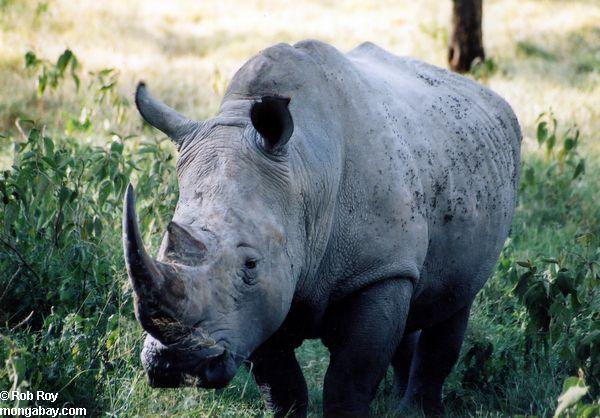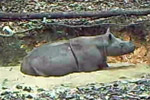The rhinoceros is one of the largest and most iconic animals to roam the earth. However, poaching for their horn, erroneously believed to have medicinal value, has led the IUCN Red List to classify three of the world’s five species as Critically Endangered. But, a new consumer report by the wildlife trade monitoring network, TRAFFIC, finds that rhino horn consumers in Vietnam buy the illegal product as much to raise their social status as to attempt to treat a fever or hangover.
Rhino horn consumed in Vietnam is largely the result of poaching in South Africa, which houses the world’s largest number of rhinos. According to Save the Rhino International, there have been 790 rhinos poached in South Africa in 2013 (as of October 25), which is an increase from 668 in 2012 and 448 in 2011. China and Vietnam are the primary markets of rhino horn, and many consumers are willing to pay large sums for powdered rhino horn.
Greater one-horned rhino (Rhinoceros unicornis) with its horn sawed off. Photo by Rhett A. Butler / mongabay.com
“In Africa, poaching of rhinos is primarily to meet the demand in Asia with many poachers being enticed to engage in poaching because they are being offered financial reward for the horns that is much higher than their usual income,” explained Naomi Doak of TRAFFIC.
In the first large-scale study of its kind in Vietnam, the consumer research interviewed a total of 720 individuals from Ho Chi Minh City and Hanoi, Vietnam’s two largest cities. The findings added insight into why Vietnamese consumers really buy illicit rhino horn. While many studies and news reports have noted that people use rhino horn for its supposed medicinal values, the report reveals that a combination of both perceived medicinal benefits and improved social status are driving booming rhino horn consumption in Vietnam.
“Across Asia, the reasons for consumption of rhino horn have differed,” said Doak. “In traditional medicine, it is believed that rhino horn can reduce fever, enhance one’s health and address a number of ailments. Since rhino horn is an expensive product in the illegal market, it has also become a symbol of wealth and power.”
The findings from the report were subsequently used to inform efforts to identify key consumer groups and aided the building of a picture of a fictional but typical consumer—
a male, 48-years-old, married, with two children around 20-years-old, who buys rhino horn to provide a sense of wealth, power, social status and hard work. According to the research, this typical consumer values success in his career, financial security, family preservation and social status—which make him vulnerable to outside influences. Above all, he believes using rhino horn gives him peace of mind and happiness. The report also generalizes these consumers as unaware of their impacts and ambivalent about the possibility of rhino extinctions, as it does not directly impact them. Many others are not even aware that rhinos have been illegally killed.

Southern white rhino (Ceratotherium simum simum). Photo by Rob Roy.
“I would say very few of us stop to think where our TVs or our new cars come from or all the impacts producing these things has on species and the environment,” said Doak. “Unfortunately it tends to be usual for us not to think about this until we reach a point where we become aware that our consumption might impact a particular species or habitat… even then we might not actually change our behavior or our level of consumption.”
This report predicts that as Vietnam’s middle class grows, so will the number of rhino horn consumers. Sixteen percent of the people surveyed that are not currently consumers of rhino horn are labeled as “intenders,” or people who plan to use or buy rhino horn in the future.
TRAFFIC and WWF Vietnam have plans to kickoff an evidence-based behavior change campaign to target the key consumer groups.
“By working on activities and actions to address demand, Vietnam can work alongside South Africa where efforts are being made to reduce poaching; by battling the problem on both sides we are confident that we can find a solution to the current poaching crisis while also address the underlying drivers of the current demand,” Doak stated.
Citations:
- TRAFFIC. Rhino horn consumers, who are they? Consumer Report. September 2013.
Related articles
New campaign: hey China, stop killing the ‘pandas of Africa’

(10/29/2013) A new public-service campaign in China will ask potential ivory and rhino horn buyers to see the victims of these illicit trades in a new light: as the “pandas of Africa.” The posters are a part of WildAid’s ‘Say No to Ivory and Rhino Horn’ campaign, which was launched earlier in the year.
790 rhinos poached in South Africa this year
(10/29/2013) 790 rhinos have been poached in South Africa this year, nearly a fifth higher than last year’s record toll, reports the Department of Environmental Affairs.
WWF risking Sumatran rhinos by releasing camera trap images, says scientist

(10/09/2013) On October 2nd, WWF released camera trap videos of Sumatran rhinos surviving in Kalimantan, Indonesian Borneo. The conservation organization had already announced in April that they had evidence of at least one Sumatran rhino in the province, but the new images confirmed what is likely to be a small surviving population. While this is good news for an animal on the edge of extinction, Erik Meijaard, a researcher who has worked in Indonesia for over 20 years, says WWF has made a mistake publicizing the news around the world, noting ‘the last thing those rhinos need is publicity.’
Unlikely success: how Zimbabwe has become a global leader in rhino conservation
![]()
(10/02/2013) With its collapsed economy, entrenched poverty, and political tremors, one would not expect that a country like Zimbabwe would have the capacity to safeguard its rhinos against determined and well-funded poachers, especially as just across the border South Africa is currently losing over two rhinos a day on average. And indeed, without the Lowveld Rhino Trust (LRT), rhinos in Zimbabwe would probably be near local extinction. But the LRT, which is centrally involved in the protection of around 90 percent of the country’s rhinos in private reserves along with conservancy members, has proven tenacious and innovative in its battle to safeguard the nation’s rhinos from the poaching epidemic.
Worst rhino poaching year on record for South Africa
(09/29/2013) At least 688 rhinos have been poached in South Africa this year, surpassing last year’s record of 668 with more than three months remaining in 2013, reports the country’s top environmental official.
Poaching jumps since South Africa announced support for legal rhino horn trade
(09/20/2013) South Africa has experienced an uptick in rhino poaching since Environmental Minister Edna Molewa called for legalizing the rhino trade, reveals analysis by the Environmental Investigation Agency (EIA).